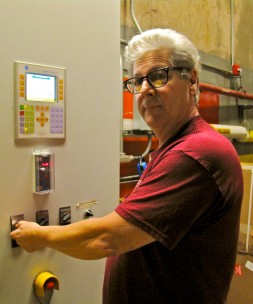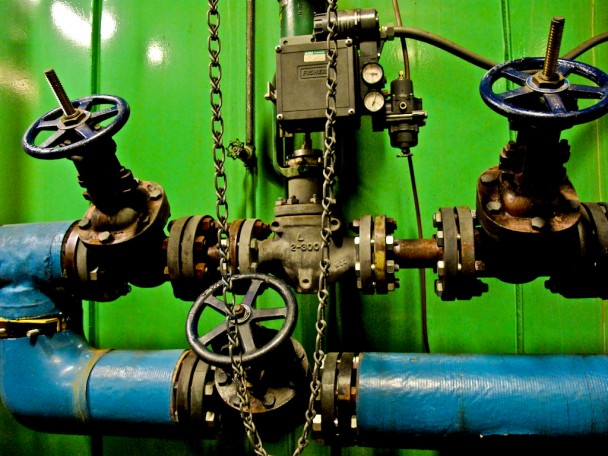
Dan Nass/Contributing Photographer Power Plant Foreman David Pompei adjusts the equipment. (Dan Nass/Contributing Photographer)
“If you grab a student and ask: ‘do you know where your utilities comes from?’ [He or she] will probably say, ‘No. You just flip a switch,’” said Central Power Plant Foreperson David Pompei.
Despite its low profile, the Central Power Plant packs quite a punch. We ventured into the depths of the underground facility to find out more.
Dante had Virgil. We had Associate Director of Utilities Management Peter Staye, as our guide.
“We generate electricity here,” he told us as we descended into the plant’s entrance on Williams Street. “We make 2.4 megawatts, which is about 85 percent of the annual consumption for the core of campus.”
An underground power plant sounds a bit like hell, and that’s the sort of landscape we expected to encounter. What we found was something quite different: a clean, cool, colorful, cavernous visual landscape of crisscrossed pipes, valves, heavy machines, and interlocking, multistory lattices of ducts and wires.
Staye led us along a metal gangway. His facial expression seemed to
indicate: “I have a complete understanding of the many various components of this facility, and I will impart unto you a small fraction of this knowledge.”
A loud industrial hum suffused the space. In a quieter control room, Staye explained more about the power plant’s role on campus.
“In addition to electricity, we also make steam here, year-round,” he said. “It’s used for heat and hot water and some processes in the sciences. We also make a thing called chilled water, which we use for air conditioning. So instead of sending out cold air, we send out cold water, and we take the heat out of the air stream for air conditions, local, inside the buildings. Air conditioning doesn’t put the cold in; it takes the heat out.”
Though there are sufficient energy sources in Middletown to power the University, according to Staye, the University’s privately-run plant is more efficient.
“Whoever built it way back when had incredible foresight,” Stayle said. “The plant is dual fuel—natural gas and oil—which provides us with several advantages. We can switch between the two depending on price, availability.”
The University is unable to generate enough power to fulfill its entire energy need. There is only one reason for this: air conditioning.
“During the winter, we make all the electricity—matter of fact, we could make more,” Staye boasted. “Loads drop down. Air conditioning is the biggest load on campus. The air conditioning system consumes 50 percent of the University’s annual electrical budget in ten weeks.”
The heat produced by generation is put toward creating steam.
“Downstairs in one of the condensate areas is actually the lowest place on campus,” Staye said. “And there’s a reason for that. We send steam out here through these lines. The buildings use that steam to make hot water or heat or whatever, taking the energy out of that steam and condensing it into water. That water then flows back through a second set of pipes following the same route to the power plant. By having this be the lowest part of the campus, all the stuff flows by gravity.”
Between engineering lessons, Staye let us clamber around near the turbine, which was fortunately not running, so we were not deafened by the 120 decibels it produces.
A few days later, we returned to the plant to talk to boiler worker Ray Mason.
“Students sometimes ask me, ‘What does it mean when there’s smoke coming out of the stacks?’” Mason told us. “I tell them, ‘That means we’re cooking down here.’”

The Central Power Facility has more valves than the Aegean Sea has sea urchins.